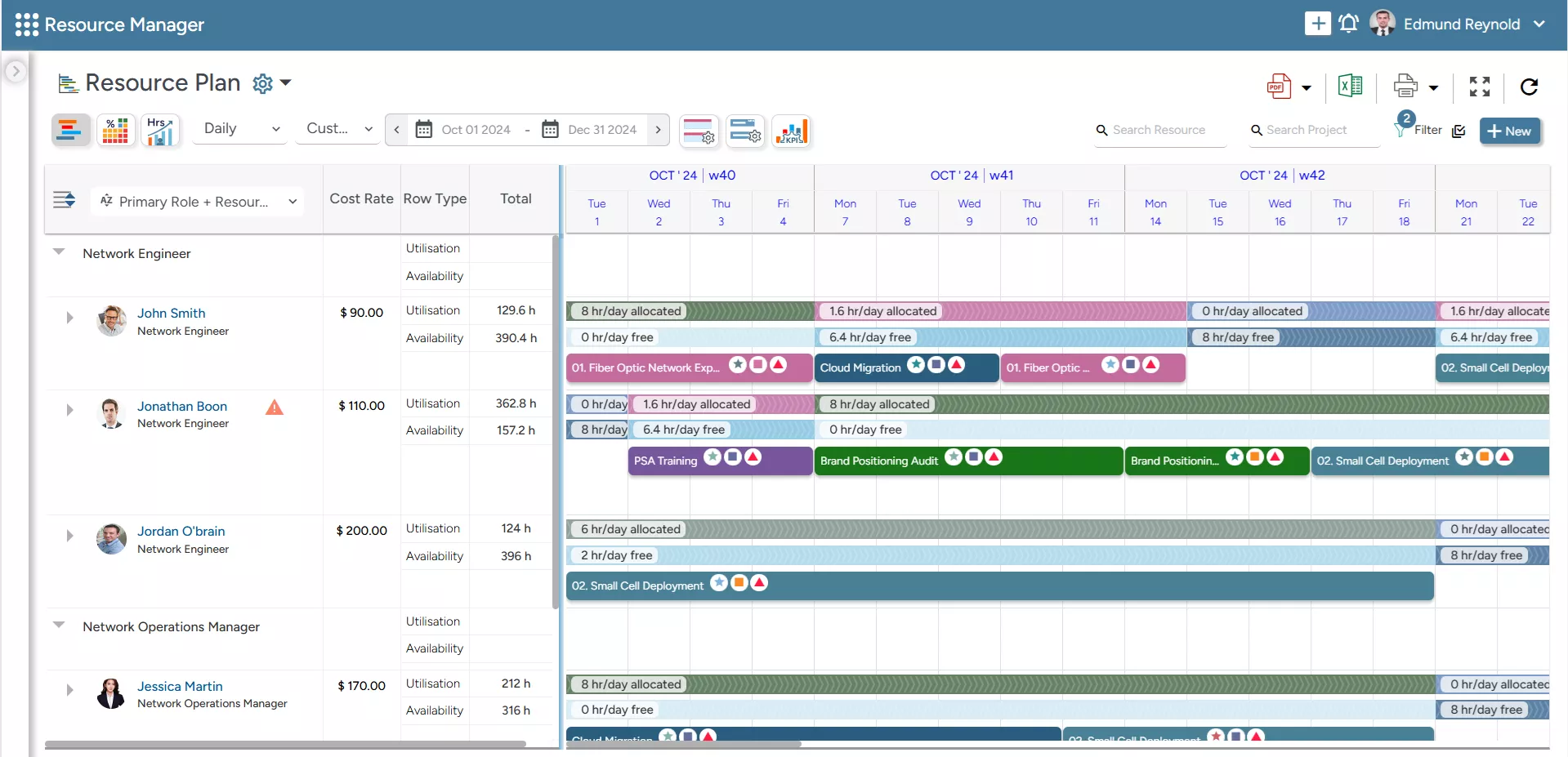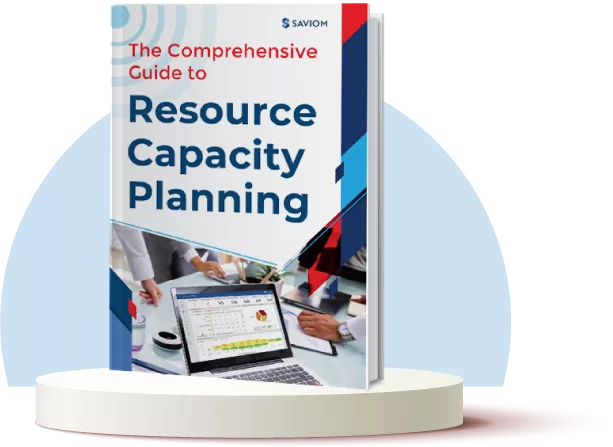Planning and executing a project without a structured approach is like driving to an unknown destination without a GPS. You might eventually reach the place, but not without unnecessary detours, delays, and wasted fuel.
Now, think of resources as the fuel that powers this journey. Without the right people in the right roles at the right time, even the best project plan could derail. As a result, organizations risk encountering delays, budget escalations, and subpar project quality. That’s where the resource matrix can help.
This powerful tool acts as a navigation system, offering managers real-time visibility into employees’ availability, skills, and workload. Thus, it allows them to identify and deploy the best-fit resources for every project task. Consequently, it helps reduce resourcing costs, maintain the project momentum, minimize the risks of over/underutilization, and enhance workforce productivity.
In this article, we will take a deep dive into the definition of the resource matrix, its key components, best practices, and steps to create one.
Let’s begin by understanding what a resource matrix is.
What is a Resource Matrix?
A resource matrix, also known as a staffing matrix or resource allocation chart, is a visualization tool that maps resources against roles, tasks, or projects. It captures key details such as resource names, designation, skill sets, competencies, assigned tasks, and availability. The resource matrix helps ensure competent allocation, minimizes the risk of sub-optimal utilization, and improves project outcomes.
By leveraging this information, managers can effectively identify, secure, and assign the right resource to the right task at the right cost and time, facilitating competent resource allocation. Consequently, this enables organizations to improve workforce productivity, improve the quality of project deliverables, and ensure project success.
Now that we know what a resource matrix is, let’s explore its key elements in the subsequent section.
Essential Components of a Resource Matrix
Here’s a list of the crucial components that must be considered while creating a resource matrix:
Resource Name
The resource matrix must include the names of employees, serving as identifiers to help managers efficiently manage teams and plan allocations. This identification label enables them to assign, monitor, and optimize resources effectively throughout the project lifecycle.
Role & Designation
This component defines the role and designation of the resources within the organization, making it easier to define responsibilities and gauge their contribution to the project’s success. Moreover, having clear role visibility helps prevent role overlaps, reduces confusion, and ensures appropriate task allocation.
Skill Set & Proficiency Level
This section outlines resource skills, competencies, and proficiency levels, allowing managers to make accurate and informed allocation decisions. Additionally, it helps identify skill mismatches and spot demand gaps, allowing organizations to plan targeted skill development initiatives to build a competent resource pool.
Read More: What is Skill Matrix, and Why is it Important for Business Success?
Resource Availability
A resource matrix offers centralized visibility into both human and non-human resources that are partially or fully available to take up new tasks or projects. Based on this insight, managers can assign suitable resources to tasks and prevent last-minute scheduling conflicts.
Cost and Charge-Out Rate
The cost rate refers to the total expense incurred by a firm to employ a resource, including salary, benefits, and overheads. In contrast, the charge-out rate is the amount billed to clients for a specific service. By leveraging this information, managers can make cost-effective and profitable allocation decisions.
Task Assignment
This element ensures that each resource based on skills, expertise, and availability is suitably mapped to a suitable task within a project. Generally depicted across a grid or table, this enables managers to quickly visualize workload distribution, identify potential resource constraints, and take timely corrective actions if needed.
Read More: What is Project Scheduling: Examples, Benefits, and Best Practices
Let’s jump to the next section, emphasizing the significant benefits of using a resource allocation matrix.
Benefits of Using a Resource Matrix
Besides mapping the right roles to the right tasks, here’s a list of some more rewarding benefits organizations can reap by harnessing a resource matrix:
Provides a Centralized Resource Visibility
The staffing chart offers enterprise-wide visibility into key resource attributes like skills/proficiency levels, capacity, availability, utilization, etc. These insights boost managers’ capabilities to ensure proper workload management, avoid scheduling conflicts, and facilitate seamless task progression.
Optimizes Resource Allocation
By offering a consolidated view of each employee’s skills, competencies, cost, availability, etc., the resource matrix empowers managers to identify and allocate the most appropriate resources to each project. This improves workforce productivity, improves project deliverables, and boosts organizational profitability.
Read More: What is Resource Allocation, and Why is it Important?
Helps Mitigate Resource-Related Risks
The resource matrix provides visibility into the workforce’s current skills, proficiencies, and availability. This enables managers to proactively identify resource risks such as workforce shortfalls, skill gaps, scheduling conflicts, etc. Accordingly, firms can take suitable corrective measures to prevent disruptions and ensure smooth project execution.
Boosts Team Collaboration & Communication
The resource allocation chart offers a clear insight into team members’ roles, skills, and current assignments. This clarity breaks down silos, promotes open communication, and fosters knowledge sharing across teams. Consequently, it strengthens collaboration, improves team efficiency, and enhances project outcomes.
Read More: 10 Ways to Improve Cross-Departmental Collaboration
Ensures Data-Driven Decision-Making
A resource matrix provides insights into key metrics such as utilization, availability, capacity, demand, etc. This enables managers to proactively assess and analyze critical information to make data-driven decisions and drive successful project outcomes.
Having understood the key benefits, the following section discusses the must-follow steps to create an actionable resource matrix.
Steps to Create an Effective Resource Matrix
Here’s a step-by-step guide to developing an effective resource matrix and streamlining your project planning:
Clearly Define the Project Scope
This is the first and most crucial step in creating an effective resource matrix. It involves outlining the project’s objectives, deliverables, timelines, milestones, and constraints. Once the project scope is well-defined, it becomes easier to determine the resource requirements, including the specific roles, skill sets, and effort needed at each stage.
This clarity helps avoid scope creep, sets realistic expectations, and ensures that the resource matrix accurately reflects the actual demands of the project. A clear scope lays the foundation for aligning the right people with the right responsibilities, leading to better planning and smoother execution.
Outline Project Tasks & Dependencies
The next step involves breaking the project into smaller, manageable tasks and subtasks to understand the work sequence. Managers can start by listing all major activities and mapping out interdependencies to ensure the completion of high-priority tasks. Consequently, this helps avoid workflow disruptions and delays.
For example, in a construction project, the foundation must be laid before framing begins, and plumbing work must be installed before sealing the walls. Similarly, painting can only start after plastering is done. Hence, mapping these dependencies ensures a logical workflow, preventing delays and rework.
Read More: How to Build a Work Breakdown Structure? A Step-by-Step Guide
Assess Resource Requirements & Availability
Now, managers must identify the number and type of resources needed to complete each task in each project phase. This includes estimating how many resources are needed, what expertise they must have, and the duration of their involvement. Furthermore, by aligning tasks to skill sets, managers get a clear picture of the ideal resource composition. Once the requirements are outlined, the next step is to evaluate the availability of resources.
Managers must check who is available to take on the project work, their current capacity, and whether they possess the necessary skills. This highlights potential talent gaps, such as skill shortages, resource unavailability, or scheduling conflicts. Therefore, it allows managers to take corrective action and ensure the availability of competent personnel for task execution.
Allocate Resources to the Tasks/Projects
In the following step, managers can start allocating the resources to the tasks based on their skills, availability, experience, cost, etc. This way, managers can create an optimal mix of resources with the right skill sets and expertise to effectively fulfill the project goals and meet stakeholders’ expectations within the predefined timeline and budget.
For example, a senior in a software development project may be assigned complex coding tasks while a junior handles bug fixes. Similarly, critical design work is given to experienced UI/UX designers, ensuring quality and efficiency. This strategic allocation of project resources helps optimize utilization, control project costs, and boost productivity.
Read More: 7 Key Steps for Soft Booking Resources for a Project
Design the Resource Matrix
With task assignments in place, managers can start structuring the resource matrix to visualize allocation precisely. They can organize the resource details in a table or grid format with two dimensions: an X-axis and a Y-axis. Each row or horizontal unit will represent a resource, while each column or vertical unit will represent a project task.
While creating a simple table in Excel works, using a project resource matrix template can be more effective. Leveraging this well-structured and detail-oriented matrix helps project managers gain centralized visibility and make data-driven resourcing decisions.
Add Resource-Related Details
Next, managers can enhance the resource matrix by including additional details such as weekly working hours, cost and charge-out rates, utilization levels, and any specific constraints or dependencies. Based on these real-time insights, they can perform better resource planning and make informed decisions to streamline the project workflow.
Moreover, keeping all relevant data in one place helps managers track performance, identify and mitigate resource-related risks, and take corrective actions to prevent deviation. Hence, the more detailed the matrix, the easier it becomes to optimize resource usage across the project lifecycle.
Read More: What is a Utilization Report and 5 Steps to Build an Effective One
Regularly Monitor & Adjust the Matrix
Lastly, it’s important to monitor and update the matrix to ensure it reflects the changing project priorities and resource allocations. They can edit the matrix if any adjustments are needed due to unexpected changes like ad hoc project changes, unplanned absences, or attrition.
For example, in a marketing campaign, if a key graphic designer is suddenly unavailable, the resource matrix can be updated. Managers can reassign the work to another available designer to ensure seamless task progression.
Now, let us shift our focus to understanding how a 5th Gen Resource Management Software can help streamline resource planning.
How Can a 5th Gen Resource Management Tool Help?
Advanced resource management software helps firms allocate best-fit resources to project tasks rather than first-visible, enhancing the project success rates. Here’s how:
- The tool has an all-in-one resource planner, which offers a multi-dimensional analysis feature, allowing managers to view the resource information in various dimensions, such as roles, skills, availability, and capacity, empowering them to make data-driven decisions for project success.
 SAVIOM’s All-in-One Resource Planner offers comprehensive visibility into all resource attributes, enabling smarter allocation decisions.
SAVIOM’s All-in-One Resource Planner offers comprehensive visibility into all resource attributes, enabling smarter allocation decisions.
- The tool’s multidimensional resource forecasting feature facilitates predicting upcoming project demands and assesses resource requirements with precision. Based on these insights, managers can effectively perform resource estimation and planning.
- Its embedded capacity planner enables managers to foresee resource excesses and shortages in advance, allowing organizations to take proactive steps to effectively balance workforce capacity with upcoming project demands.
- The tool’s intelligent match-making feature assists managers in aligning the most suitable resources with the right projects at the right time and cost. This ensures efficient allocation of talent, driving productivity, reducing project costs, and minimizing resource-related challenges.
- The tool’s smart KPI forecaster offers managers a precise view of key resource metrics like capacity, availability, utilization, skill gaps, people on the bench, etc. These insights aid managers in making informed decisions and planning with confidence.
- With a real-time competency matrix, managers can easily document, monitor, and update employees’ skills, expertise, and certifications within the organization. Offering detailed skill insights helps identify gaps and implement focused training and development initiatives.
- Finally, the tool’s what-if analysis allows managers to simulate and compare multiple allocation scenarios based on factors like budget, demands, etc., and come up with the best-fit resource plan for projects.
Read More: How Can You Make Data-Driven Decisions with Resource Management Software?
The next section delves deeper into the best practices to consider while creating a resource matrix.
Conclusion: Best Practices for Using Resource Matrix
Keep the following tips in mind to unleash the full potential of the resource allocation matrix:
Use Color-Coding to Enhance Comprehension
By assigning distinct colors to represent different resource metrics like availability, utilization, capacity, etc., users can quickly scan the matrix and understand conditions at a glance. This visual clarity eliminates the need to sift through detailed data, making it easier to identify issues and make informed decisions.
Include Detailed Resource Information to Prevent Scheduling Conflict
Beyond just listing names and roles, the matrix should capture key details such as skill sets, current allocations, availability, location, work hours, and any planned time off. This comprehensive view helps managers avoid scheduling conflicts such as double-booking, overbooking, or skill-task misalignment.
Use Placeholders If Applicable
Instead of leaving gaps in the resource matrix, placeholders can be used to represent future or tentative resource needs. This allows managers to account for all project requirements during the planning stage, even if the exact individuals are not yet identified. It’s a proactive way to prevent last-minute scrambles.
Make the Matrix Accessible to All
Managers must ensure that all relevant key stakeholders and team members can access the matrix in real-time. By making it accessible and handy, it helps foster better collaboration and facilitates transparency. It also encourages feedback and timely updates, keeping the data accurate and relevant.
The Glossary
Read More: Glossary of Resource Workforce Planning, Scheduling and Management










